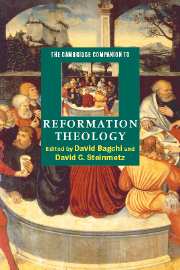Book contents
- Frontmatter
- Introduction
- 1 Late medieval theology
- 2 Lollardy
- 3 Hussite theology and the law of God
- 4 The theology of Erasmus
- 5 Luther
- 6 Melanchthon
- 7 Confessional Lutheran theology
- 8 The theology of Zwingli
- 9 Bucer
- 10 The theology of John Calvin
- 11 John Calvin and later Calvinism
- 12 The theology of Thomas Cranmer
- 13 The theology of the English reformers
- 14 The Scottish Reformation
- 15 An introduction to Anabaptist theology
- 16 Catholic theologians of the Reformation period before Trent
- 17 The Council of Trent
- Conclusion
- Select bibliography
- Index
- Series list
15 - An introduction to Anabaptist theology
Published online by Cambridge University Press: 28 May 2006
- Frontmatter
- Introduction
- 1 Late medieval theology
- 2 Lollardy
- 3 Hussite theology and the law of God
- 4 The theology of Erasmus
- 5 Luther
- 6 Melanchthon
- 7 Confessional Lutheran theology
- 8 The theology of Zwingli
- 9 Bucer
- 10 The theology of John Calvin
- 11 John Calvin and later Calvinism
- 12 The theology of Thomas Cranmer
- 13 The theology of the English reformers
- 14 The Scottish Reformation
- 15 An introduction to Anabaptist theology
- 16 Catholic theologians of the Reformation period before Trent
- 17 The Council of Trent
- Conclusion
- Select bibliography
- Index
- Series list
Summary
Modern scholarship identified a variety of reform movements within what continues to be called the Reformation. Besides the major distinction between Protestant and Catholic, or geographical distinctions (such as the English Reformation), one encounters socio-political designations, such as the princely, the city or communal reformation. Of course, the older, more purely theological distinctions between a Lutheran and Reformed (Calvinist) Reformation have lived on as well. The notion of a 'Radical Reformation' entered the historiography with George Williams' encyclopedic work by that title in 1962. His basic distinction between 'magisterial' and 'radical' reformers has shaped the nomenclature to the present. 'Magisterial' designates those reformers who received support from or collaborated with temporal authorities, be they civic or princely. The radicals, by choice or default, received no such support. Williams' third edition (1992) used both theological and social categories to designate radicals. Thus evangelical rationalists, antitrinitarians, Anabaptists, spiritualists, as well as rebellious peasants, appear under the rubric of radical reformation. Given the topological sweep of his work from Spain to Poland, its erudition and generous spirit, Williams' work remains a classic.
Williams’ daunting work is also an impossible act to follow. This essay will be more restricted, focused primarily on the Anabaptists, who make up the core of studies on the radical reformation. But even this shrinkage of focus faces the challenge of diversity. The uninitiated may well despair as to the variety of crusading, pacifist, evangelical, antitrinitarian, sabbatarian, communistic, apocalyptic,mystic-spiritualistic and biblically literalistic Anabaptists. Any attempt at distilling theological essence from such manifest variety seems at best a hazardous undertaking.
- Type
- Chapter
- Information
- The Cambridge Companion to Reformation Theology , pp. 194 - 219Publisher: Cambridge University PressPrint publication year: 2004
- 4
- Cited by

